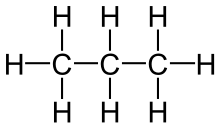Geminal
In chemistry, the descriptor geminal refers to the relationship between two atoms or functional groups that are attached to the same atom. The word comes from Latin gemini meaning "twins".[1] A geminal diol, for example, is a diol (a molecule that has two alcohol functional groups) attached to the same carbon atom, as in methanediol. Also the shortened prefix gem may be applied to a chemical name to denote this relationship, as in a gem-dibromide for "geminal dibromide".
The concept is important in many branches of chemistry, including synthesis and spectroscopy, because functional groups attached to the same atom often behave differently from when they are separated. Geminal diols, for example, are easily converted to ketones or aldehydes with loss of water.[2]
| Alkane | geminal | vicinal | isolated | |
| Methane |  |
 |
not existing | not existing |
| Ethane |  |
 |
 |
not existing |
| Propane |  |
 |
 |
 |
| Substituents on selected dibromoalkanes labeled red. | ||||
The related term vicinal refers to the relationship between two functional groups that are attached to adjacent atoms. The relative arrangement of two functional groups can also be described by the descriptors α and β.
1H NMR Spectroscopy
In 1H NMR spectroscopy, the coupling of two hydrogen atoms on the same carbon atom is called a geminal coupling. It occurs only when two hydrogen atoms on a methylene group differ stereochemically from each other. The geminal coupling constant is referred to as 2J since the hydrogen atoms couple through two bonds. Depending on the other substituents, the geminal coupling constant takes values between −23 and +42 Hz.[3][4]
Synthesis
The following example shows the conversion of a cyclohexyl methyl ketone to a gem-dichloride through a reaction with phosphorus pentachloride. This gem-dichloride can then be used to synthesize an alkyne.

References
- ↑ entry for "geminal" in the Oxford online dictionary of American English. Accessed on 2013-01-27.
- ↑ Peter Taylor (2002), Mechanism and synthesis, Book 10 of Molecular world. Open University, Royal Society of Chemistry; ISBN 0-85404-695-X. 368 pages.
- ↑ H. Günther: NMR-Spektroskopie; Grundlagen,Konzepte und Anwendungen der Protonen- und Kohlenstoff-13-Kernresonanzspektroskopie in der Chemie. 3. neubearbeitete und erweiterte Auflage, Georg Thieme Verlag, Stuttgart 1992, S. 103.
- ↑ D. H. Williams, I. Fleming: Strukturaufklärung in der organischen Chemie; Eine Einführung in die spektroskopischen Methoden. 6. überarbeitete Auflage, Georg Thieme Verlag, Stuttgart 1991, S. 109.